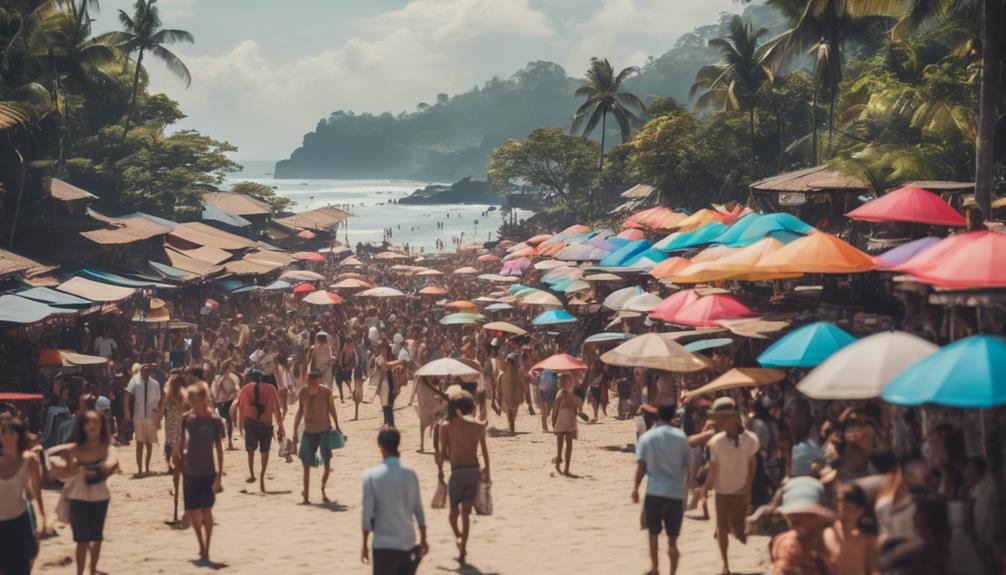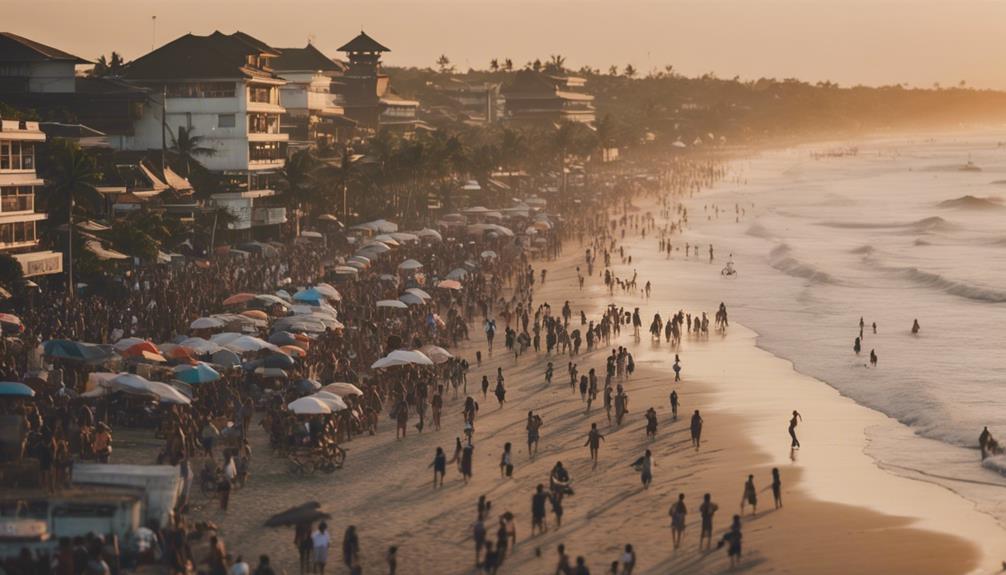Has Bali Become Too Touristy?
As the saying goes, 'too much of a good thing can be bad.'
You've likely heard about the paradise-like destination Bali, an island known for its amazing beaches, vibrant culture, and lush landscapes.
But has the constant influx of tourists started to tarnish its charm?
And what about the impact on local communities and the environment?
You might find some surprising insights as you look into this issue, leaving you to ponder whether Bali has indeed become too touristy.
Key Takeaways
- Bali's tourism boom has led to economic growth but also strains on culture, environment, and infrastructure.
- The island's wildlife is negatively impacted by tourism, leading to issues like animal trafficking.
- Cultural erosion is a significant concern, with traditional practices compromised due to commercialization.
- Sustainable tourism strategies, including exploring less-visited regions and supporting local businesses, are crucial for preserving Bali's natural and cultural uniqueness.
Bali's Tourism Boom

You've probably noticed Bali's explosive tourism boom, a phenomenon that's transformed this once-quiet island into a bustling travel destination. This surge has been a double-edged sword, impacting both the local economy and tourist etiquette in unprecedented ways.
On the one hand, the local economy has seen an uptick. Businesses catering to tourists, from hotels to restaurants and souvenir shops, have proliferated. Jobs have been created, providing new opportunities for the local population. On the other hand, this boom has put traditional Balinese culture under pressure, leading to changes in tourist etiquette.
You might've witnessed this in the form of stricter rules around dress codes at temples or increased sensitivities around photographing local rituals. These changes are designed to protect the essence of Balinese culture while accommodating the influx of visitors. Bali's tourism boom, therefore, isn't just about the number of people visiting the island but also the shifts in local economy and etiquette that come with it.
To respect these changes, innovation is needed from both tourists and residents. As a visitor, you have a role in this by being mindful of local customs and contributing positively to the local economy.
Environmental Impact of Tourism
You're now confronted with the question of how tourism is impacting Bali's environment.
Consider the effect of increasing tourist numbers on local wildlife.
The strain on waste management systems is another crucial aspect to analyze.
Furthermore, the erosion of local culture may be an unintended consequence.
It's important to understand these points to grasp the full picture of Bali's tourism dilemma.
Tourism's Effect on Wildlife
It's impossible to ignore the significant impact that tourism has on Bali's diverse wildlife and ecosystems, leading to both positive and negative consequences. Increased visitor numbers have unfortunately spurred animal trafficking, exploiting the island's unique species for profit. Many of these creatures are endangered, their populations dwindling as they're snatched from their habitats.
On the flip side, tourism's revenue can fund conservation efforts, providing essential support to help preserve Bali's rich biodiversity. However, balancing the economic benefits with the ecological costs requires innovative solutions. Engaging tourists in sustainable practices and implementing stricter regulations can curb the negative impacts on wildlife. Ultimately, it's about nurturing a tourist industry that respects and protects Bali's natural wonders.
Waste Management Challenges
Tourism, while often viewed as a boon, frequently exacerbates Bali's waste management challenges, contributing to a growing environmental crisis on the island. As a visitor, you're part of an industry that generates massive amounts of waste, most prominently plastic pollution. This onslaught of waste overwhelms Bali's limited garbage disposal infrastructure, leading to litter-strewn beaches and polluted waters.
Innovative solutions are urgently needed. You could contribute by opting for eco-friendly alternatives, reducing your plastic usage, and supporting local businesses that prioritize sustainable practices. By doing so, you're not just enjoying Bali's beauty but also helping to preserve it. Remember, your actions today will impact the Bali of tomorrow. Let's make sure it's a positive impact.
Erosion of Local Culture
Beyond the environmental toll, there's a profound cultural erosion happening in Bali due to the invasive footprint of tourism. This is where your role in cultural education and preservation initiatives comes in.
To help you better understand this, let's look at the table below:
| Impact of Tourism | Effect on Local Culture | Suggested Solutions |
|---|---|---|
| Over-commercialization | Dilution of authentic traditions | Promote responsible tourism |
| Loss of local languages | Erosion of cultural identity | Encourage language preservation initiatives |
| Unbalanced economic growth | Widening of social inequality | Support local businesses |
| Neglect of cultural sites | Degradation of heritage | Advocate for preservation initiatives |
| Misrepresentation of culture | Stereotyping and cultural disrespect | Enhance cultural education |
You see, you can help mitigate this impact. It's about balancing the benefits of tourism with preserving Bali's rich and diverse culture.
Effect on Local Culture
As you contemplate the effect of tourism on Bali's local culture, it's important to understand the possible erosion of traditional practices due to outside influence.
There's also the commercialization of sacred sites to ponder, which can lead to an oversimplification or misrepresentation of cultural significance.
Additionally, the issue of cultural appropriation raises concerns about the potential exploitation and commodification of Balinese culture for the benefit of tourists.
Erosion of Traditional Practices
In exploring the impact of tourism on Bali, you can't overlook the slow erosion of traditional practices, a phenomenon that's gradually reshaping the island's distinct local culture.
You'll notice a noticeable shift in the culinary scene, where traditional cuisine alteration is increasingly apparent. Local dishes, once prepared with indigenous ingredients and age-old techniques, are now often modified to cater to international palates, compromising authenticity.
This loss of culinary heritage reflects the broader compromise of Balinese traditions. The incessant push for innovation and novelty for tourist satisfaction has driven a wedge between the island's heritage and its future, raising concerns about the sustainability of Bali's unique cultural identity in the face of booming tourism.
Commercialization of Sacred Sites
Another repercussion of tourism's rapid growth in Bali is the commercialization of sacred sites, a development that's substantially impacting local culture. This Religious Commodification manifests in three ways:
- The conversion of temples into tourist attractions.
- The sale of spiritual ceremonies as tourist experiences.
- The exploitation of sacred artifacts as souvenirs.
This Sacred Site Exploitation is changing the very essence of local culture. It's not only eroding the sanctity of these sites but also altering the way locals perceive and practice their traditions.
Innovation is needed to develop sustainable tourism strategies that respect and preserve the island's cultural heritage. It's time for you to become part of the solution and not the problem.
Cultural Appropriation Concerns
Beyond the commercialization of sacred sites, you'll also find that cultural appropriation presents a significant concern, markedly affecting Bali's local culture. Tourists often flout dress code norms at temples and religious ceremonies, showing disrespect. This dress code disrespect isn't just a disregard for the local customs but also a form of cultural appropriation that undermines the sanctity of these places.
Similarly, the proliferation of inauthentic souvenirs often misrepresents Balinese art and craftsmanship, further diluting the culture. These trinkets, marketed as 'traditional', are often poor imitations, contributing to the erosion of the authentic Balinese culture. It's important to acknowledge these issues, and aim for more responsible tourism practices, to guarantee the preservation of Bali's rich cultural heritage.
The Rising Cost of Living
As Bali's tourism industry flourishes, you'll notice a marked increase in the cost of living, impacting both locals and tourists alike. This rise is a direct consequence of the gentrification effects, where previously affordable areas transform into high-end localities. The expatriate influx has also added to the demand-supply equation, pushing prices upwards.
You may wonder, how does this impact life on the island? Well, let's contemplate three main areas:
- Housing: With more tourists and expatriates seeking accommodation, rents have skyrocketed. This has made it challenging for locals to afford decent housing.
- Groceries: As demand for imported goods increase, so does their price. This results in an overall rise in grocery bills.
- Transportation: With the roads filled with rental cars and taxis, public transport has become costlier.
While the tourism boom might seem beneficial at first glance, it's crucial to ponder its implications on the cost of living. Indeed, innovation in sustainable tourism practices is necessary to make sure that while Bali continues to charm visitors, it remains liveable for its residents. As we move forward, balancing these two aspects will be a critical challenge.
Overcrowding and Infrastructure Issues

Not only does the escalating cost of living pose a challenge, but the influx of tourists and expats has also led to overcrowding, causing significant strain on Bali's infrastructure. Roads strain under the weight of countless taxis, private cars, and scooters. The once tranquil beaches now bustle with bodies, and peaceful temples teem with selfie-stick wielding tourists, often flouting local norms of tourist etiquette.
The local displacement is also a growing concern. Many Balinese find themselves pushed out of their homes and neighborhoods, driven away by escalating costs and the clamor of tourism. The local way of life, rich with history and culture, is gradually eroding, replaced by a tourism-driven economy.
The sustainability of Bali's infrastructure is another critical issue. Water scarcity, waste management, and traffic congestion are but a few of the problems that need innovative solutions. It's not just about building more roads or installing more pipes. The real challenge is to devise strategies that balance the needs of tourism with the preservation of Bali's unique culture and environment.
It's imperative to remember, you, as a tourist, can be part of the resolution. By practicing responsible tourism, respecting local customs, and supporting local businesses, you can help guarantee Bali remains the paradise it's known to be.
The Positive Side of Tourism
Despite the challenges, tourism in Bali isn't all doom and gloom; it has brought about numerous benefits, particularly in the economic sector. The island's enchanting culture and breathtaking landscapes continue to attract tourists from around the globe, and this influx has its silver lining, too.
Let's highlight three key points:
- Economic Growth: Tourism is the backbone of Bali's economy. It generates substantial income, contributing notably to the island's GDP. This growth has led to an improved standard of living and prosperity for many locals.
- Development of Infrastructure: With tourism, there's the need for better facilities and services. This demand has led to the development of improved infrastructure such as roads, airports, and accommodations.
- Cultural Preservation: Interestingly, tourism has also played a role in preserving Bali's rich cultural heritage. The global interest in Bali's unique culture has encouraged the preservation and promotion of traditional arts, crafts, and ceremonies.
Exploring Less-Visited Bali Regions

Let's venture off the beaten path and explore the less-visited regions of Bali, where you can still experience the island's authentic charm and untouched beauty. Venture into West Bali National Park, where you can explore lush rainforests and spot rare wildlife. The park's pristine, hidden beaches offer a peaceful retreat away from the bustling tourist crowds.
Take a trip to the regency of Karangasem, home to some of Bali's most undiscovered temples. Nestled on hills or hidden within jungles, these sacred sites are steeped in history, and their remote locations preserve their serene atmosphere. If you're an adventure seeker, Jembrana might be your next stop with its challenging surf breaks and off-road biking trails.
Consider the tranquil region of North Bali, where you can discover idyllic waterfalls and lakes, as well as traditional markets that are rich in local culture. The region's secluded resorts offer unique opportunities for relaxation and rejuvenation.
In these less-visited regions of Bali, you're not just a tourist—you're an explorer, a learner, and a part of the local community. So, immerse yourself in the island's hidden wonders and embrace the authentic Bali experience.
Maintaining Bali's Authenticity
While exploring these less-visited regions provides a taste of Bali's authentic charm, it's equally important to address how the island can preserve its unique cultural heritage and natural beauty amidst the growing tourism industry.
To maintain Bali's authenticity, it's critical to look for innovative strategies. One such approach is authentic cuisine preservation. As a traveler, you can drive demand for traditional Balinese food by patronizing local eateries, thereby supporting the continued existence of these culinary traditions.
Balinese craft protection is another aspect to contemplate. By buying locally made crafts and products, you're not only supporting the local economy, but also contributing to the preservation of traditional crafting techniques.
To clarify, here are three key strategies you can adopt:
- Patronize local eateries and learn about Bali's authentic cuisine.
- Buy local crafts, supporting the artisans and their traditional methods.
- Advocate for responsible tourism practices that respect Bali's natural and cultural uniqueness.



